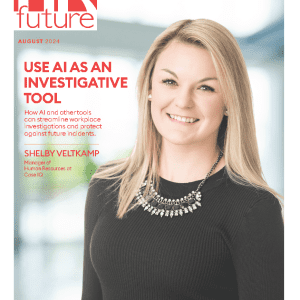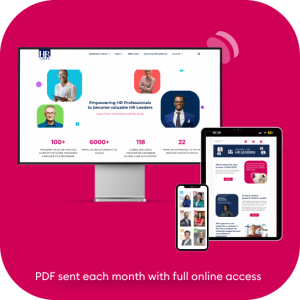Prakash Santhanam shares with Alan Hosking some of the HR trends he has spotted emerging in the international community.
How is HR leveraging technology to streamline recruitment processes?
HR is embracing AI-powered tools to screen resumes, establish positive candidate experiences, engage candidates through chatbots, and adopt video interviewing platforms to enhance the efficiency of remote hiring.
AI enhances applicant tracking systems (ATS) and manages candidate data, enabling HR teams to handle the recruitment pipeline more effectively, while predictive analytics supports top recruitment sources, increases retention strategies, and aids in creating more targeted talent acquisition strategies.
AI-based assessments evaluate candidates’ skills, knowledge and abilities through psychometric tests, simulations and coding challenges, offering more insights into their capabilities. Overall, AI optimizes various stages of recruitment, enhancing speed, accuracy and comprehensive candidate experience while empowering HR in making data-driven and quality decisions in the recruitment processes.
What are the emerging trends in employee wellness programs?
Employee wellness programs are rapidly progressing and evolving to encompass holistic well-being. Several trends include personalized wellness initiatives, mental health support, flexible work arrangements and tech-driven platform offerings. At the same time, employers are focusing on proactive approaches to promote a holistic health and work-life balance.
A creative approach in employee wellness is highly critical as it supports retention strategies. Tech-driven wellness solutions such as online mental health resources, wellness apps, personalized wellness initiatives and wearable devices are emerging as integral parts of wellness programs, stimulating employee engagement and accessibility.
HR can consider designing wellness initiatives to be inclusive, taking into account various cultural backgrounds, abilities and lifestyles in ensuring employees feel valued, involved, supported and included.
What shifts are anticipated in performance management strategies?
Conventional annual performance reviews are fading away and moving towards continuous feedback practices. HR is giving more importance to regular check-ins, goal setting and ongoing performance conversations.
There’s a shift towards aligning individual goals with organizational objectives and having qualitative assessments, emphasizing employee skills development instead of just evaluating past performance. Performance management is progressively cantered around identifying and fostering skills development.
This involves establishing customized and creating personalized Individual Development Plan (IDP) in supporting employees in their careers. HR is also leveraging feedback from subordinates, peers and other stakeholders to provide a comprehensive view of an employee’s performance, nurturing a holistic performance management.
The change is happening more in prioritizing employee growth and development, providing opportunities for learning and skill enhancement gearing towards support career progression. HR technology solutions are enabling performance management, ensuring easier goals tracking, feedback collection, and data analysis to identify trends and areas for improvement.
How are diversity and inclusion initiatives evolving in the workplace?
D&I efforts are shifting beyond numerical diversity to establish an inclusive atmosphere in ensuring employees feel valued, respected, and empowered to contribute their unique perspectives. This involves crafting safe spaces for discussions, promoting empathy, and addressing unconscious biases in the workplace.
There’s a strong need for leadership accountability in driving diversity and inclusion initiatives.
Organizations are re-evaluating and redesigning policies and practices to ensure they are inclusive, such as equitable promotion opportunities, inclusive hiring practices, creating diverse and inclusive teams and setting specific, measurable diversity and inclusion goals and ensuring accountability with frequent tracking progress and making adjustments as needed.
Other initiatives include extending their diversity and inclusion efforts beyond their own walls by engaging with the community, supporting diverse causes and actively contributing to social change.
Organizations are emphasizing equity and representation at all levels and HR is implementing diversity training, ensuring unbiased hiring practices, establishing diverse interview panels, conducting pay equity audits and creating an inclusive workplace where everyone feels respected and valued. The target is not just for representation but also for establishing a genuine inclusive and equitable workplace culture.
How is HR addressing the changing landscape of employee benefits?
As employee benefits are changing so too is HR. HR has embarked on offering benefits packages such as exploring flexible benefits packages, fitness incentives, stress management resources, wellness programs, emphasizing mental health benefits and considering employee preferences to customize benefits meeting the expectations and suitability of diverse needs in the workforce.
Prioritizing employee well-being by including in benefits packages is a priority. More flexibility includes adapting benefits to accommodate remote work by offering allowances for home office setups, virtual mental health support, and flexible working hour arrangements.
Ensuring benefits packages are inclusive and considerate of diverse needs, such as offering childcare assistance, family and community benefits such as voluntary time off (VTO), parental leave and inclusive healthcare options. In helping employees managing their finance, HR can provide resources for financial planning, education, and benefits such as student loan assistance, retirement planning, and financial counselling.
Utilizing technology to provide easier access to benefits information, enrollment, and management, often through user-friendly platforms or mobile apps is highly relevant and crucial. HR departments are emphasizing the importance of educating employees about available benefits, their usage and the value they provide, often through regular communication channels.
They’re also keeping abreast of changing regulations and legal requirements to ensure that benefit packages remain compliant with local laws and industry standards.
How is HR managing the skills gap in the workforce?
They are investing in upskilling and reskilling programs, collaborating with educational institutions and offering learning and development opportunities catering to the evolving needs of the roles and organization. Additionally, HR has to identify and cultivate internal talent.
Through these approaches, HR has targets to bridge the skills gap by fostering a learning culture, providing targeted learning and development opportunities via Individual Development Plan (IDP), and aligning employee skills with the evolving needs of the organization and the industry.
HR designs and implements training initiatives, both internal and external, to upskill existing employees.
These programs cover technical skills, leadership skills, soft skills and industry-specific knowledge. Another effective method is internal mobility (Build approach) by identifying talent within the organization and offering opportunities for advancement through mentorship, job rotations and career development paths.
Fostering a culture of continuous learning and innovation, encourages employees to take ownership of their development and providing resources for self-directed learning. With the emergence of AI, leveraging e-learning platforms, AI-based learning tools and gamification ensure learning becomes more accessible, engaging and tailored to employee learning styles and preferences.
What strategies are HR departments implementing to enhance employee engagement?
HR employs strategies such as regular feedback mechanisms, employee recognition programs, career development opportunities and initiatives that promote a healthy work-life balance to enhance employee engagement.
HR implements regular feedback mechanisms, such as surveys, town halls and one-on-one check-ins to gather employee feedback, address concerns and keep communication channels open.
Implementing recognition programs to acknowledge and appreciate employees’ efforts and achievements, be it through verbal recognition, awards, or incentives, is beneficial.
Providing clear paths for career development, offering training, mentorship programs, and opportunities for advancement within the organization, as well as offering wellness initiatives, including health benefits, fitness programs, mindfulness sessions, and access to mental health resources, supports employees’ holistic well-being.
On the other hand, Employee Assistance Programs (EAPs) provide confidential counselling, support, and resources for employees facing personal or work-related challenges and help improve workplace wellness. A good employee engagement effort covers the three elements of recreation and bonding, communication, and motivation.
Prakash Santhanam boasts expertise in Meta NLP, CIPD, DDI, Insights, Situational Leadership II, DiSC, Hogan, and Harrison certifications, backed by a decade-spanning global career.
As a dedicated Talent Management and HR professional, he’s instrumental in steering organizations toward global eminence, revolutionizing talent strategies across selection, development, engagement, retention, and digital transformation. His portfolio spans across IT, telecommunications, education, automotive, animal health, construction, and agriculture.
























